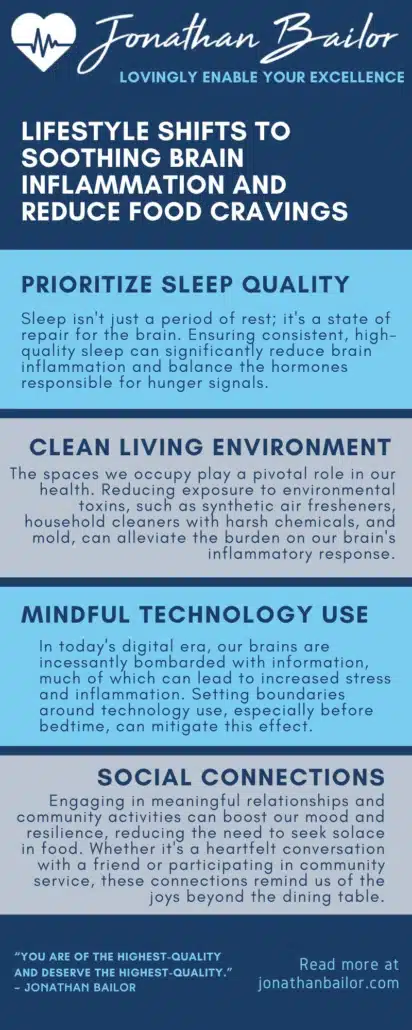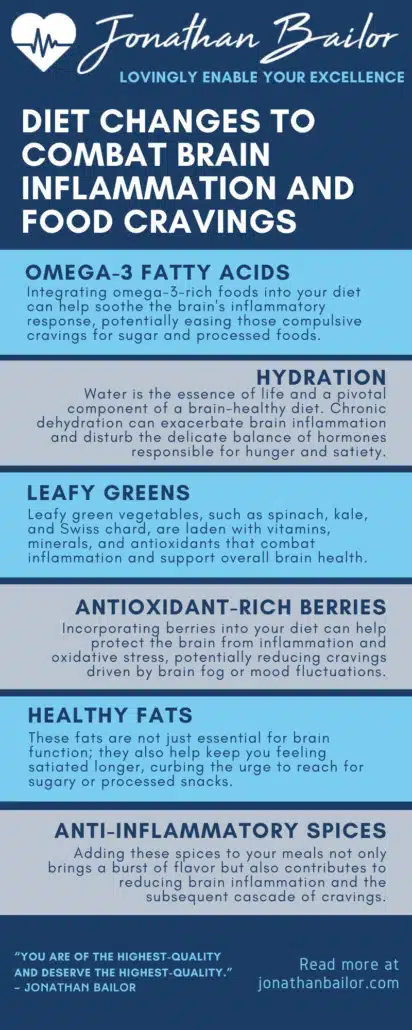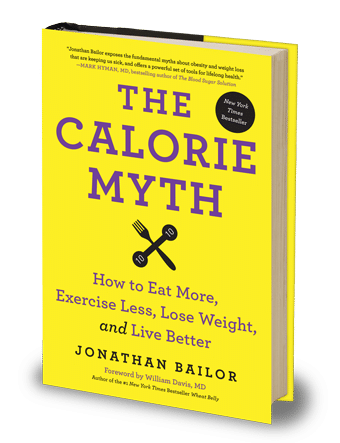19 Natural Strategies for Soothing Brain Inflammation AND Food Cravings
Are those pesky food cravings driving you up the wall? Interestingly, the answer might not lie in your stomach but in your brain! Recent insights reveal a fascinating link between chronic brain inflammation and irresistible food cravings. Imagine being able to calm that inner urge for sweets or salty snacks simply by soothing your brain. This approach could revolutionize how we think about dieting and weight management. Explore further strategies for nurturing your brain health and managing food cravings in the comprehensive Brain Health Guide by Jonathan Bailor.
Though brain inflammation is most often associated with a traumatic brain injury, neurodegenerative diseases, such as Alzheimer’s, or impairments in the central nervous system, chronic inflammation in the brain is often caused by an impaired blood-brain barrier due to lifestyle and dietary habits and can usually be corrected.
Chronic brain inflammation—a silent dilemma often undetected due to its subtle symptoms—may play a villainous role in sabotaging our dietary efforts. But fear not; for every problem, there’s a solution. In this case, nature itself offers a bounty of strategies to combat both brain inflammation and the resulting food cravings.
Let’s embark on a transformative journey, exploring natural methods to ease our brain’s distress and bring our food desires under control. From the foods we eat to the lifestyle we lead, small changes can significantly impact our well-being. This journey is not just about losing weight or overcoming cravings; it’s about discovering a path to a healthier, more balanced life.
Embracing these strategies can empower us to take charge of our health, making informed choices that benefit our brain and, by extension, our entire body. So, let’s dive into these natural remedies and lifestyle adjustments, unraveling their potential to soothe our brains, pacify our cravings, and elevate our overall health.
And, as we journey through this enlightening path, remember: knowledge shared is power multiplied. If you find this information transformative, don’t keep it to yourself. Share it with friends, family, or anyone you believe could benefit from a new perspective on managing food cravings and enhancing brain health. Together, we can pave the way toward a healthier, more fulfilled community.
Lifestyle Shifts: Soothing Brain Inflammation and Quieting Food Cravings
Embarking on a journey to mitigate brain inflammation and curb food cravings doesn’t solely revolve around what’s on our plate or our physical activities. It encompasses a broader spectrum of our daily routines. From the air we breathe to the environments we inhabit, subtle lifestyle adjustments can foster a harmonious balance within, promoting brain health and diminishing those nagging cravings. While lifestyle changes are vital, certain individuals with persistent health concerns may explore medical options, such as weight loss drugs, as part of a comprehensive plan recommended by their healthcare provider.
Let’s explore four transformative lifestyle changes that, while simple, can have profound effects on our well-being.
1. Prioritize Sleep Quality
Sleep isn’t just a period of rest; it’s a state of repair for the brain. Ensuring consistent, high-quality sleep can significantly reduce brain inflammation and balance the hormones responsible for hunger signals. Aim for a serene sleeping environment, free from electronic distractions, and establish a soothing pre-bedtime routine. This practice not only rejuvenates the mind but also steadies our craving impulses, making it easier to make healthier choices upon waking.
2. Cultivate a Clean Living Environment
The spaces we occupy play a pivotal role in our health. Reducing exposure to environmental toxins, such as synthetic air fresheners, household cleaners with harsh chemicals, and mold, can alleviate the burden on our brain’s inflammatory response. Opt for natural cleaning products, ensure adequate ventilation, and introduce indoor plants that can purify the air. A cleaner living space not only benefits the brain but also creates a sanctuary for wellness.
3. Embrace Mindful Technology Use
In today’s digital era, our brains are incessantly bombarded with information, much of which can lead to increased stress and inflammation. Setting boundaries around technology use, especially before bedtime, can mitigate this effect. Dedicate time to unplug and engage in activities that nourish the soul, such as reading a book or spending time in nature. Mindful technology use can help preserve our brain’s health and reduce the impulse for comfort foods as a stress response.
4. Foster Social Connections
Human connection is a profound source of comfort and joy, often acting as a natural antidote to stress and inflammation. Engaging in meaningful relationships and community activities can boost our mood and resilience, reducing the need to seek solace in food. Whether it’s a heartfelt conversation with a friend or participating in community service, these connections remind us of the joys beyond the dining table.
By weaving these lifestyle changes into the fabric of our daily lives, we not only soothe brain inflammation but also address the root causes of food cravings. This holistic approach offers a pathway to not just better health but a more fulfilled and balanced life. Remember, the journey to wellness is a mosaic of small choices that, together, create a masterpiece of health and happiness.

Feeling Better Is Priceless, That's Why We Don't Put A Price On It!
“It’s Like A Free and Medically Valid Version of Noom and Weight Watchers Online”
~ Dr. Doctor Matthew Oleshiak, MD
Click the 'LEARN MORE' button below for free lifetime access to the fast fix program developed by Jonathan and top Ivy League Medical Doctors
LEARN MOREP.S. It's not a free trial. It's not part of the program for free. The entire program is free, forever, for real! No credit card needed.
Nourishing the Brain: Diet Changes to Combat Inflammation and Cravings
While our lifestyles undeniably shape our health’s canvas, the palette of foods we consume profoundly colors our well-being. Specifically, the relationship between our diet, brain inflammation, and food cravings is intricate, suggesting that what we eat can either fuel inflammation or extinguish it. After all, eating unhealthy foods damages the blood-brain barrier over time, allowing foreign substances to seep into the brain regions and leading to activated microglia, the brain’s immune cells.
This section illuminates dietary adjustments aimed at soothing brain inflammation, thereby naturally reducing the urge for unneeded snacking. Each change is a step towards a diet that not only nurtures the brain but also aligns our cravings with our body’s genuine needs. But remember, it’s also important to practice mindful eating to take full advantage of these brain-healing dietary strategies.
1. Incorporate Omega-3 Fatty Acids
Omega-3 fatty acids are like the guardians of brain health, wielding the power to quell inflammation and balance mood. Found abundantly in fatty fish such as salmon, mackerel, and sardines, as well as in flaxseeds and walnuts, these essential fats are crucial for brain function and reducing inflammation. Integrating omega-3-rich foods into your diet can help soothe the brain’s inflammatory response, potentially easing those compulsive cravings for sugar and processed foods.
2. Hydrate with Purpose
Water is the essence of life and a pivotal component of a brain-healthy diet. Chronic dehydration can exacerbate brain inflammation and disturb the delicate balance of hormones responsible for hunger and satiety. By prioritizing hydration—aiming for eight glasses of water a day—you’re not only supporting your brain’s health but also naturally reducing the likelihood of mistaking thirst for hunger.
3. Elevate Your Intake of Leafy Greens
Leafy green vegetables, such as spinach, kale, and Swiss chard, are laden with vitamins, minerals, and antioxidants that combat inflammation and support overall brain health. Their high fiber content also plays a role in stabilizing blood sugar levels, which can help manage food cravings. A daily serving of leafy greens contributes to a diet that supports cognitive function and reduces the temptation of unnecessary snacking.
4. Choose Antioxidant-Rich Berries
Berries, with their vibrant colors and rich antioxidant content, are not just a treat for the palate but also for the brain. Blueberries, strawberries, and blackberries are among the fruits known for their anti-inflammatory properties thanks to their high levels of flavonoids. Incorporating berries into your diet can help protect the brain from inflammation and oxidative stress, potentially reducing cravings driven by brain fog or mood fluctuations. They are healthy snacks that your brain needs.
5. Opt for Healthy Fats
Healthy fats, particularly those found in avocados, nuts, and seeds, support brain health by fostering a stable energy source and reducing inflammation. These fats are not just essential for brain function; they also help keep you feeling satiated longer, curbing the urge to reach for sugary or processed snacks. By making healthy fats a cornerstone of your diet, you’re choosing to fuel your body and brain in a way that diminishes the desire for formerly craved foods naturally.
6. Spice It Up with Anti-Inflammatory Spices
Turmeric, ginger, and cinnamon are more than just flavor enhancers; they’re also potent anti-inflammatory agents. Turmeric, for instance, contains curcumin, a compound with significant anti-inflammatory properties, especially when paired with black pepper to enhance absorption. Adding these spices to your meals not only brings a burst of flavor but also contributes to reducing brain inflammation and the subsequent cascade of cravings. Research shows that there’s a strong link between brain inflammation and Alzheimer’s disease.
In some cases, addressing dietary habits alone may not suffice, and healthcare providers might suggest weight loss medications for compatible individuals alongside other strategies to help manage food cravings effectively.
Embracing these dietary changes invites a symphony of nutrients that work in concert to reduce brain inflammation and naturally align our food cravings with our body’s nutritional needs. This harmonious approach to eating doesn’t just feed the body; it nourishes the brain and soul, paving the way for a life of enhanced well-being and satisfaction.

Energizing the Mind: Physical Activities to Ease Brain Inflammation and Curb Cravings
While the journey to mitigate brain inflammation and manage food cravings encompasses various facets of our lives, incorporating purposeful physical activity stands out as a particularly dynamic path. Movement not only oxygenates and revitalizes our bodies but also acts as a natural balm for our brains, easing inflammation and recalibrating the mechanisms that influence our cravings.
This section highlights activities designed to foster brain health, offering a proactive approach to diminishing the desire for unhelpful snacking. Through these activities, we find a potent remedy in our body’s inherent ability to heal and maintain equilibrium.
1. Moderate-Intensity Aerobic Exercise
Aerobic exercise, such as brisk walking, cycling, or swimming, performed at a moderate intensity, is a wonderful tonic for the brain. Engaging in these activities for at least 30 minutes a day can enhance blood flow to the brain, reducing inflammation and releasing endorphins that naturally suppress food cravings. This type of exercise strikes a balance, ensuring that it’s not just the body that’s being cared for; the brain is also receiving its share of attention, keeping cravings at bay through enhanced mood and cognitive function.
2. Yoga for Mind and Body Harmony
Yoga transcends physical activity, entering the realm of meditative movement. The gentle stretches combined with deep breathing techniques found in yoga can significantly lower stress levels, a known contributor to brain inflammation and erratic food cravings. By aligning the body and mind, yoga offers a sanctuary of calm, diminishing the brain’s inflammatory response and fostering a state of balance where cravings are less likely to take root.
3. Strength Training for Cognitive Clarity
Integrating strength training into your weekly routine isn’t just about building muscle; it’s also about fortifying your brain. Activities such as weight lifting or bodyweight exercises, performed two to three times a week, can improve insulin sensitivity, reducing inflammation and stabilizing blood sugar levels. This stability is crucial for minimizing sudden food cravings and supporting overall brain health, making strength training an invaluable tool in the quest for cognitive clarity and control over cravings.
4. Outdoor Activities for Enhanced Well-being
Embracing outdoor activities, like hiking, kayaking, or simply walking in nature, can profoundly affect brain health. The combination of physical movement, exposure to natural light, and the calming influence of nature works synergistically to lower stress hormones, reduce inflammation, and decrease cravings. This connection with the natural world encourages a state of mindfulness and gratitude, further aligning our physical activities with our body’s deeper needs for health and harmony.
5. Dance as a Joyful Release
Dance is a celebration of movement, offering a unique blend of physical activity, emotional expression, and creativity that benefits both the body and the brain. Regular engagement in dance, whether in a class setting or alone in your living room, stimulates the release of endorphins and supports neural growth factors that combat inflammation. This joyful form of exercise can elevate mood, combat stress, and decrease the likelihood of turning to food for emotional comfort, illustrating that movement can indeed be medicine.
Incorporating these physical activities into our daily or weekly routines invites a cascade of benefits beyond mere bodily health. They offer a pathway to reducing brain inflammation and controlling cravings, embodying the principle that through movement, we can achieve a state of wellness that nourishes every aspect of our being.
Mindful Harmony: Mental and Spiritual Practices to Soothe Brain Inflammation and Diminish Cravings
In the realm of achieving holistic health, the symbiosis between our mental and spiritual well-being and our physical body cannot be understated. Our thoughts, emotions, and spiritual practices wield the power to influence our physiological states, impacting brain inflammation and the intricate dance of cravings. By nurturing our mental and spiritual selves, we pave a path toward tranquility that extends its calming influence to our neural pathways.
This section is dedicated to exploring mental and spiritual practices that can not only quiet the storm of brain inflammation but also harmonize our internal environment to reduce the pull of cravings. Each suggested practice offers a step towards inner peace and wellness, illuminating the profound impact our mental and spiritual health can have on our physical well-being.
1. Meditation for Mindful Awareness
Meditation is a powerful conduit for achieving a state of deep relaxation and mindfulness. Regular meditation practice can help lower stress levels, reducing the production of cortisol, a hormone that exacerbates brain inflammation and triggers cravings. By spending a few minutes each day in meditation, focusing on the breath or a mantra, we invite clarity and calmness into our minds, diminishing the chaos that can lead to impulse eating. This practice of mindful awareness nurtures a peaceful mental state, encouraging choices that align with health and well-being.
2. Gratitude Journaling to Shift Perspective
Expressing gratitude through journaling can transform our mental landscape, shifting focus from lack to abundance. By regularly noting down things we are grateful for, we foster a positive mindset that’s been shown to reduce stress and its inflammatory effects on the brain. This shift in perspective can also diminish the emotional need for comfort foods as we begin to find joy and satisfaction in the non-material aspects of our lives. Gratitude journaling is a gentle yet potent tool for cultivating a spirit of contentment and resilience.
3. Guided Imagery for Stress Reduction
Chronic brain inflammation, or neuroinflammation, can be caused by chronic stress, so regular stress reduction is essential to prevent this issue. Guided imagery is a form of focused relaxation that encourages peace and calm by visualizing positive, serene images and scenarios. This practice can significantly lower stress, decrease brain inflammation, and alter our emotional responses to cravings. By mentally transporting ourselves to a place of serenity, we can momentarily disengage from the world’s stresses, reducing the urge to seek comfort in food. Engaging in guided imagery can serve as a mental escape, offering solace and reducing the physiological stress responses that fuel inflammation and cravings.
4. Spiritual Connection Through Nature
Connecting with nature spiritually can profoundly affect our mental health and, subsequently, our brain’s inflammatory state. Whether it’s a walk in the park, sitting by a lake, or simply spending time in a garden, immersing ourselves in the natural world can help us feel a more profound sense of peace and connection to something greater than ourselves. This spiritual engagement with the environment promotes mental well-being, reduces stress, and naturally decreases cravings by fulfilling our innate need for connection and belonging. Nature offers a backdrop for physical activity and a spiritual sanctuary that nurtures our minds and spirits, aligning our health holistically.
By embracing these mental and spiritual practices, we acknowledge the profound interconnectedness of our emotional, spiritual, and physical health. Cultivating mental tranquility and spiritual depth acts as a balm, soothing the inflammation within our brains and easing the compulsions that drive our cravings. In this holistic approach, we find a comprehensive strategy for wellness that honors the complexity of our being and fosters a journey toward lasting health and peace.
FAQ: Nurturing Your Brain Health
Understanding how to support brain health is paramount in our journey towards holistic well-being. The brain, a central hub of function and perception, requires nurturing through our lifestyle, diet, and activities.
Here, we address common inquiries about maintaining and enhancing brain health, offering insights into practices that foster a vibrant, well-functioning mind.
1. What role does hydration play in brain health?
Hydration is critical for optimal brain function. The brain comprises about 75% water, and even slight dehydration can impair memory, mood, and cognitive functions. Adequate water intake supports brain structure, facilitates the removal of toxins, and delivers essential nutrients to brain cells. Ensuring you drink sufficient water throughout the day can help maintain focus, clarity, and energy levels, reducing the risk of inflammation and supporting overall brain health.
2. How does physical exercise benefit the brain?
Physical exercise is not just for the body; it’s also a boon for the brain. Regular physical activity increases blood flow to the brain, enhancing cognitive functions and neurogenesis (the production of new neurons). Exercise also promotes the release of neurotrophic factors, which support neuron survival and plasticity. Furthermore, it can reduce the risk of developing neurodegenerative diseases and improve mood and sleep quality, all of which are beneficial for long-term brain health.
3. Can mindfulness and meditation impact brain health?
Mindfulness and meditation have profound effects on the brain. These practices can lower stress levels, decrease brain inflammation, and enhance areas of the brain responsible for memory, attention, and emotional regulation. Regular meditation can also thicken the prefrontal cortex, improve cognitive abilities, and decrease the age-related decline in brain structure and function. You can foster a healthier, more resilient brain by incorporating mindfulness and meditation into your routine.
4. What dietary components are crucial for maintaining brain health?
A diet rich in omega-3 fatty acids, antioxidants, and vitamins is crucial for brain health. Omega-3 fatty acids, found in fatty fish, flaxseeds, and walnuts, support brain cell structure and function. Antioxidants from berries, leafy greens, and nuts combat oxidative stress that can damage brain cells. Vitamins such as B-complex, found in avocados and legumes, and vitamin D, obtained from sunlight exposure and fortified foods, are essential for optimal brain function and mood regulation.
5. Are there medical treatments to help manage cravings linked to brain inflammation?
Certain medical options, including weight loss drugs, may be recommended for certain individuals whose cravings are linked to underlying health issues. These treatments are typically considered as part of a personalized plan under professional guidance.
6. Is there a connection between sleep and brain health?
Sleep plays a pivotal role in brain health. During sleep, the brain undergoes processes that remove toxins accumulated throughout the day, consolidate memories, and repair brain cells. Lack of sleep can increase stress hormones, inflammation, and impaired cognitive functions, such as decision-making and problem-solving abilities. Prioritizing quality sleep—aiming for 7-9 hours nightly—can enhance brain function, mood, and overall health.
By addressing these aspects of our lives, we can support our brain’s health and function, ensuring a foundation for overall well-being and vitality. Our brain’s health influences every aspect of our existence, underscoring the importance of nurturing it through thoughtful practices and choices.
Embrace and Share the Journey to Brain Health
In exploring pathways to enhance brain health and diminish cravings, we’ve uncovered the integral role of lifestyle, diet, physical activity, and mental/spiritual practices. These insights offer strategies and a holistic approach to nurturing our brain, promising a more balanced and vibrant life. As we venture forth on this journey of well-being, let’s not walk alone.
Share this treasure trove of knowledge with friends and family through social media platforms and email. Together, we can embark on a transformative journey, fostering a community where brain health is a shared quest and a wellspring of collective vitality.
Feeling Better Is Priceless, That's Why We Don't Put A Price On It!
“It’s Like A Free and Medically Valid Version of Noom and Weight Watchers Online”
~ Dr. Doctor Matthew Oleshiak, MD
Click the 'LEARN MORE' button below for free lifetime access to the fast fix program developed by Jonathan and top Ivy League Medical Doctors
LEARN MOREP.S. It's not a free trial. It's not part of the program for free. The entire program is free, forever, for real! No credit card needed.




